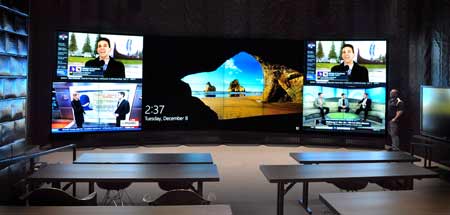When would a video wall be the better option than a large projector?
When deciding between a video wall and a large projector, it’s important to remember that LED video walls are the pinnacle of large display technology and are the superior choice in most applications. Although, there are some situations where a projector can provide an acceptable level of performance at a lower cost, but those situations are typically very specific. This is what the differences of large display formats looks like:1. LED video walls offer a richer and brighter picture – Although large format projectors have made significant gains in quality and crispness, there are some disadvantages that they cannot overcome. Specifically, a large projector has to project the image onto a screen, and that image must reflect off of the screen so that it can be perceived by observers. This winding path that the image has to take reduces its brightness and sharpness considerably, as some of the visual data is lost in the exchange.
LED video walls are backlit, so their images are better controlled and remain brighter. This difference is often clearly demonstrated in any specification listing. Projector brightness is measured in lux whereas LED display brightness is measured in NITs. A single NIT offers more than triple the brightness of a single lux, and modern LED video walls offer thousands of NITs per display. There’s no realistic projector light source that could compete with that.
Color contrast and richness are better represented with LED video walls as well. Projectors have issues with producing highly saturated colors, especially black. That’s why projected images always appear a bit washed out.
This brightness, contrast and saturation advantage may be even more pronounced over time, as projectors tend to lose their brightness well before LED displays experience similar issues.
Put it all together, and LED video walls are the clear favorite in any setting where the display must compete with ambient or environmental light. LED displays are far more effective in exterior applications and in large venues, where the amount of ambient light would overwhelm most large projectors.
2. LED video walls generate higher resolution images, while projectors can produce larger images – LED displays are on the leading edge in high resolution formats, and many are compatible with Ultra HD resolutions as well. There are some projectors that can match this level of detail, but they are more expensive than standard definition projectors, and the difference in cost will generally make them a less efficient choice.
A single projector, though, can produce a larger image than a single LED display. In some cases, this can be in excess of 120 inches, but with an LED video wall, another display can always be added, so this size advantage is minimal.
3. LED video walls need regular maintenance, while projectors need regular replacement – With an LED video wall, there are a lot of components involved, so they need to be inspected regularly to ensure they are functioning optimally. An upshot to this is that even though LED video walls require frequent maintenance, when a display suffers an issue, it won’t bring the entire wall down. If the video wall is large enough, the failing display may not even be particularly noticeable.
Compared to an entire bank of LED displays, most projectors will go longer between technical issues, but projector lamps burn out quickly and need to be replaced often. Further, projectors have to be cleaned and maintained to extend their life. Otherwise, the entire projector will need to be replaced before long. Another problematic maintenance-oriented concern is that when a projector experiences a fault, it usually brings the entire thing down, so there is no image whatsoever until the fault is corrected.
4. LED video walls are easier to configure, while projectors are easier to install – A video wall is a challenge for any non-expert to handle. It’s a project that should always be left to an A/V integrator as they can reliably and safely install a video wall. Projectors are usually easier to install, as the physical demands on the underlying structure are far less.
However, projectors can be tricky to configure, and this is especially true of older models. If the projectors are used to project onto a 3D model or environment, this level of calibration will require an expert. LED video walls, though, are designed to be operated by people with minimal technical skills. Even updating the video wall is something that most people can do without trouble. If there is a maintenance issue, then yes, technical personnel will be needed, but day to day operation is a cinch.
5. LED video walls cost more up front, but make up for this cost with time – LED video walls are about 20 percent more expensive, initially, than a projector of similar size. Eventually, though, the cost of projector light engine replacement will even out the cost because light engines intended for professional use can be rather expensive.



